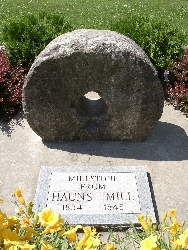Today October 30, in the afternoon of 1838, a mob consisting of more than 200 men descended upon Haun’s Mill settlement. Haun’s Mill was named after Jacob Haun, a member of the Church, who built a mill on Shoal Creek between 1835 and 1836. Mills of the period were typically three stories in height, to permit grain storage in the upper level, grinding on the main floor, and machinery below. At that time there were an estimated 75 families living there, although there were only perhaps a dozen or so houses along with a blacksmith shop and a mill.
This site is mainly thought of because of its tragic incident. However, the focus for this site of the week is on the miracles the Lord performed for those who suffered innocently from the unfortunate choices of others’ freedom to choose.
Below is an account of the Healing of Alma Smith. Afterwards, a short summary of Haun’s Mill incidences can be found. If interested, a detailed account by Joseph Young can be found in History of The Church of Jesus Christ of Latter-day Saints, volume 3: 183-186.
“Flesh, hip bone, joint and all had been ploughed out… We laid little Alma on a bed in our tent and I examined the wound. It was a ghastly sight. I knew not what to do…yet was I there, all that long, dreadful night, with my dead and my wounded, and none but God as our physician and help. ‘Oh my Heavenly Father,’ I cried, ‘what shall I do? Thou seest my poor wounded boy and knowest my inexperience. Oh, Heavenly Father, direct me what to do!’ And then I was directed as by a voice speaking to me.
…Our fire was still smouldering…I was directed to take…ashes and make a lye and put a cloth saturated with it right into the wound…again and again I saturated the cloth and put it into the hole… , and each time mashed flesh and splinters of bone came away with the cloth; and the wound became as white as chicken’s flesh. Having done as directed I again prayed to the Lord and was again instructed as distinctly as though a physician had been standing by speaking to me. Near by was a slippery-elm tree. From this I was told to make a … poultice and fill the wound with it…the poultice was made, and the wound, which took fully a quarter of a yard of linen to cover…was properly dressed…I removed the wounded boy to a house…and dressed his hip; the Lord directing me as before. I was reminded that in my husband’s trunk there was a bottle of balsam. This I poured into the wound, greatly soothing Alma’s pain.
‘Alma my child,’ I said, ‘you believe that the Lord made your hip?’
‘Yes, mother.’
‘Well, the Lord can make something there in the place of your hip, don’t you believe he can, Alma?’
‘Do you think that the Lord can, mother?’ inquired the child, in his simplicity.
‘Yes, my son,’ I replied, ‘he has showed it all to me in a vision.’
Then I laid him comfortably on his face, and said: ‘Now you lay like that, and don’t move, and the Lord will make you another hip.’ So Alma laid on his face for five weeks, until he was entirely recovered—a flexible gristle having grown in place of the missing joint and socket, which remains to this day a marvel to
physicians…It is now nearly forty years ago, but Alma has never been the least crippled during his life, and he has traveled quite a long period of the time as a missionary of the gospel and is a living miracle of the power of God.” (Quoted in James E. Faust, “The Shield of Faith,” Ensign, (May 2000), 17.)
During the attack, many of the Saints ran into the blacksmith shop where members of the mob placed their rifles in the cracks between the logs and opened fire. Many were killed during the attack or died shortly after because of wounds inflicted. Because of the cold, and fearing another attack, fourteen of the dead were hastily interred in an unfinished well near the blacksmith shop. Remaining survivors of the “Haun’s Mill Massacre” and church disciples were driven from the state. Upon departure, Haun sold the mill. It continued to operate until 1845 then it was torn down.
In 1887, Josiah Fuller’s son came to hunt up his father’s resting-place. With assistance, he moved a red millstone fragment from the old mill onto the well to commemorate those who died. The stone was partially buried edgeways. The red stone apparently remained in place at the well site until 1941 when area resident, Glen E. Setzer, cast a concrete marker near the entry road. Perhaps unaware of the meaning of the red sandstone standing over the wellsite, Setzer moved it to the new marker site. The location of the well has been uncertain ever since.
Taken from:
History of The Church of Jesus Christ of Latter-day Saints, 7 vols., introduction and notes by B. H. Roberts [Salt Lake City: The Church of Jesus Christ of Latter-day Saints, 1932-1951], 3: 183-186)
James E. Faust, “The Shield of Faith,” Ensign, (May 2000), 17.
Internet 10-30-2011 : http://www.mormonhistoricsitesfoundation.org/USA/missouri/caldwell/haunsMill/complete.pdf


Recent Comments